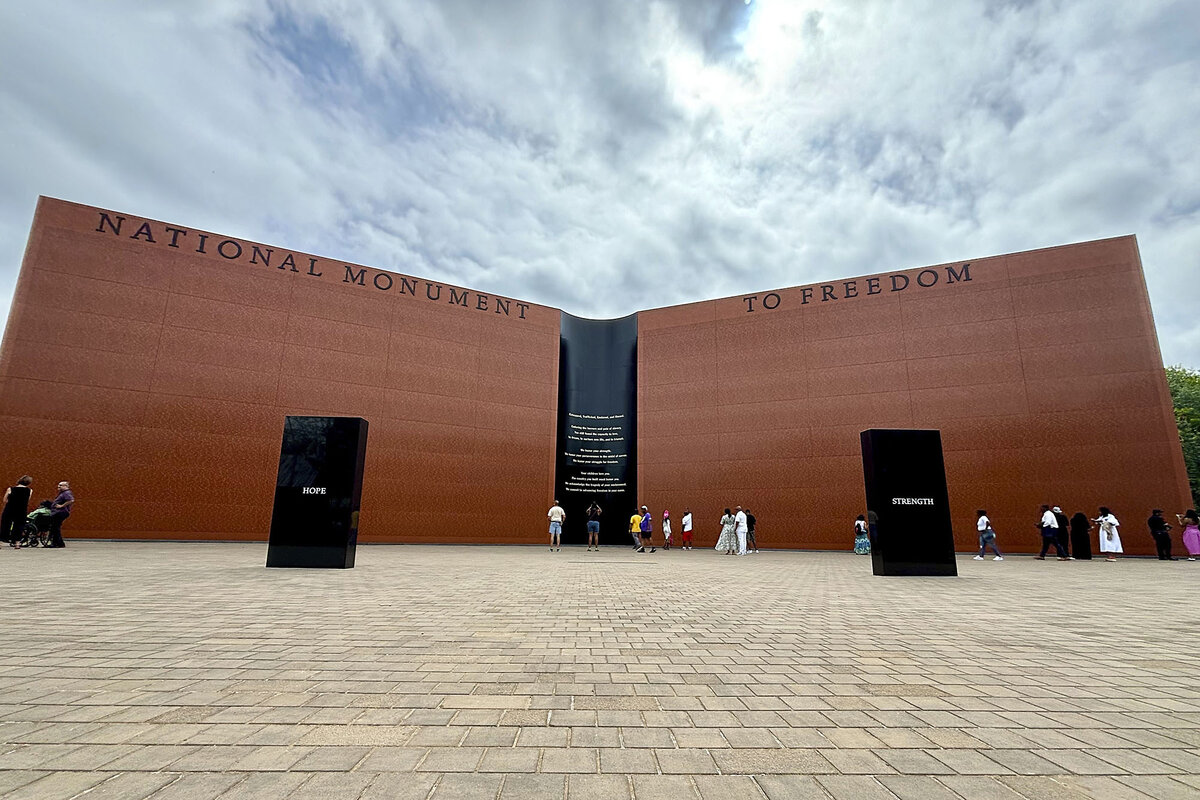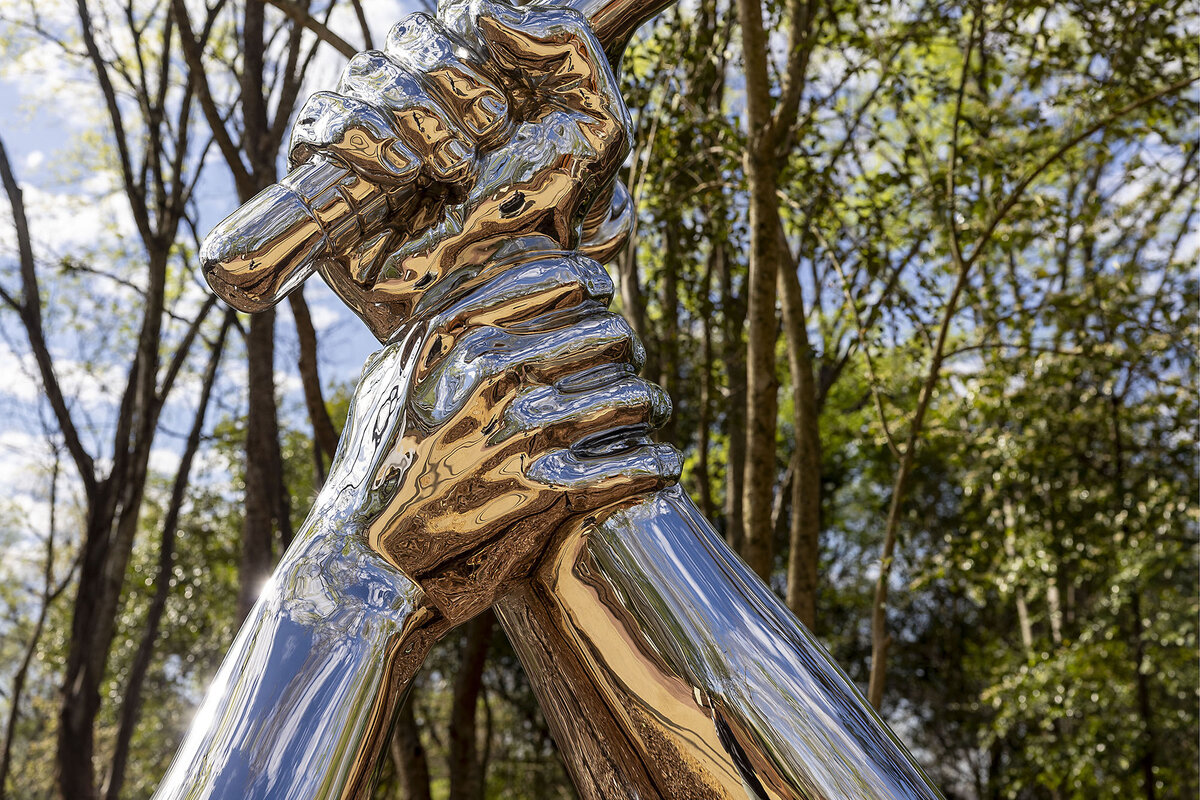This wall has 122,000 names on it. It’s a testament to people who survived.
Loading...
| MONTGOMERY, ALA.
Walls, within the framework of nationalism, have often been tools of isolation and division. Those border walls have been found in the Far East, in Europe, and in America.
Bryan Stevenson, famed lawyer and the executive director of the Equal Justice Initiative, had a different vision for a wall. Sure, it would cast an intimidating shadow reflective of the nation’s dark past. But it would also carry an inscription of freedom and perseverance to celebrate formerly enslaved Black people and their descendants.
The National Monument to Freedom is part of the Freedom Monument Sculpture Park, one of EJI’s trio of Legacy Sites in Montgomery, Alabama. Etched into it are 122,000 last names – ones people chose after emancipation.
Why We Wrote This
A story focused onHow do you capture both the atrocities of slavery – and the dignity of the people who survived it? Our columnist visited the offerings at the new Freedom Monument Sculpture Park in Montgomery, Alabama. He calls it “an overwhelming experience.”
“When enslaved people took these names, they created an identity in America that would last for generations,” Mr. Stevenson said in an interview after the monument’s dedication this summer on Juneteenth. “I didn’t fight in the Vietnam War, but I honor those people who were killed. I didn’t fight in the World Wars, but I honor those people who fought. And I think every American should honor these people who gave so much and got so little.”
What is it like to visit the Freedom Monument Sculpture Park?
These EJI sites and projects aren’t just exemplary in terms of dignity. They also elicit an intimate understanding of the atrocities committed against Africans in the American experience.
That intimacy is such a priority that EJI only allows patrons to take pictures at the front of the Freedom Monument Sculpture Park. On-site interviews with visitors are also discouraged, which, in hindsight, was an advantage to this writer. It allowed me to fully engage with the park, not only as a historian, but as a Black man. It was an overwhelming experience.
Last year, I visited the International African American Museum in Charleston, South Carolina, and ran into a woman who seemed emotionally shaken by what she had experienced. As it turned out, she, like me, was inspired by the resilience of “our people.”
Charleston is mentioned in the sculpture park, alongside an ignominious figure – 150,000 – the number of enslaved people brought to and through South Carolina’s shores. It was a number that brought me to tears – a cruel reminder of how that piece of South Carolina’s coast was ground zero for chattel slavery in America.
If Charleston was the gateway to America for more than 100,000 Africans, then Mr. Stevenson’s sculpture park is a gateway to outlining the full Black American experience. There are chains, plantation dwellings, and cruel depictions of a most harsh period in American history. Shrouded in woodland, the park isn’t just earthy. It contains a gravity that suggests this soil has soulfulness.
What happens next is a journey toward resistance and perseverance. Along my way through the park, I was greeted by a larger model of Strike, a stainless steel sculpture created by Hank Willis Thomas in 2018 that I first encountered as part of the “Giants” exhibit at the Brooklyn Museum. There was also a sculpture of a hand that made it seem as if a tree was growing out of its palm, a reference to the roots of Black folk.
Daniel Popper’s larger-than-life-size Hallow sculpture also grabbed me and didn’t let go. A glass fiber sculpture reinforced by concrete steel, it is an image of a Black woman opening herself up for the world to see. I stopped there for a few minutes, thinking of the legends of praying grandmothers and other incomparable women. I thought about Malcolm X’s commentary about the most disrespected and unprotected person in America.
“My name is on that wall”
Finally, I arrived back at the place where I started – the National Monument of Freedom. “My name is on that wall,” Mr. Stevenson told me in our interview. “I was surprised at how emotional it was for me to finally see my name, Stevenson, someplace, in a place of honor, and to think about my grandparents and great-grandparents.”
Later that day, I visited the other two Legacy Sites – the National Memorial for Peace and Justice, and the Legacy Museum. I also went to the Montgomery riverfront, which had a history of racial angst before last year’s infamous brawl. I thought about the intentionality of those sites, and the importance of telling the truth, however uncomfortable.
“I think in many ways, this becomes the center of what we’re trying to do, because you can’t understand lynching without slavery. You can’t understand segregation and Jim Crow without slavery,” Mr. Stevenson said. “I don’t think you can understand mass incarceration and many of the challenges that we see today without understanding this history. So, yes, this is a very, very special place for me.”








